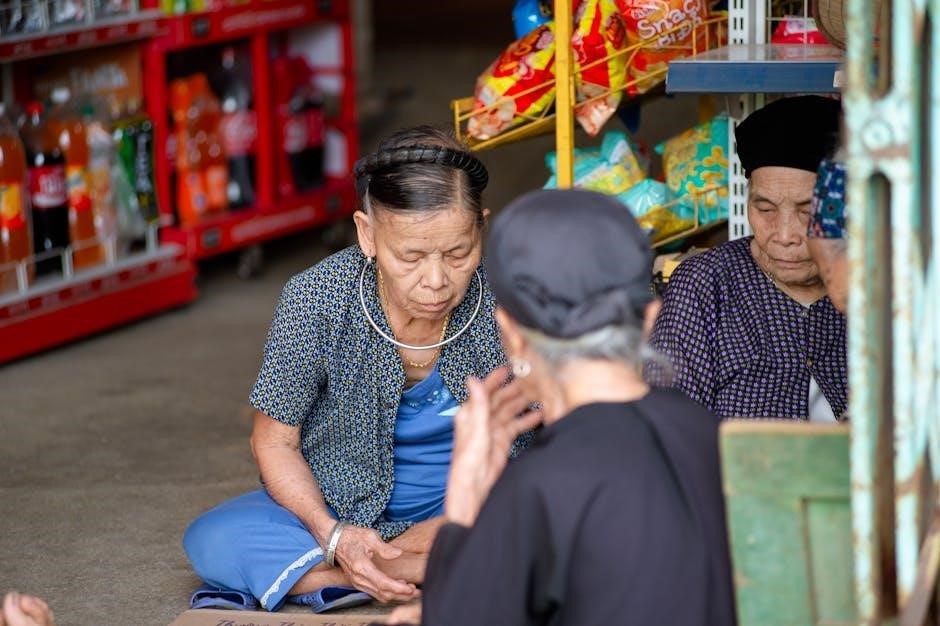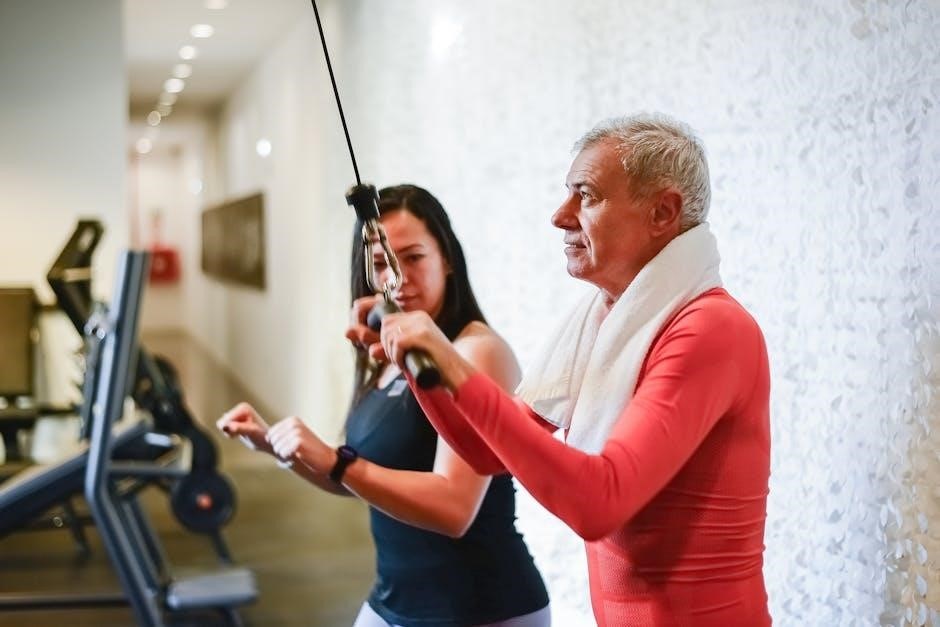a guide to midwestern conversation

a guide to midwestern conversation
The Midwest is known for its polite, welcoming demeanor and strong community ties, often influenced by agriculture and a down-to-earth lifestyle․ Understanding its unique humor and regional pride helps bridge cultural gaps and fosters meaningful connections․
Understanding the Core Values of Midwestern Conversations
Midwestern conversations are deeply rooted in values like politeness, humility, and community․ People often prioritize being approachable and down-to-earth, avoiding boasts or overly assertive behavior․ This reflects a culture where harmony and mutual respect are highly valued․
Residents often express appreciation for simple things, such as agriculture, weather, or local traditions, which fosters a sense of shared identity․ Conversations tend to be inclusive, with an emphasis on active listening and genuine interest in others’ experiences․
Humor, often self-deprecating or dry, is used to connect without seeking the spotlight․ These values create a welcoming atmosphere, making Midwesterners known for their warm and approachable communication style․
The Role of Politeness and Hospitality in Midwestern Interactions
Politeness and hospitality are cornerstones of Midwestern interactions, reflecting a deep-seated respect for others․ People often use phrases like “please” and “thank you” frequently, and offering help or a welcoming smile is commonplace․
Hospitality extends beyond words; it’s about creating a comfortable environment․ For instance, offering a guest a drink or a seat is a standard gesture of kindness․ This emphasis on being gracious fosters trust and rapport․
Midwesterners tend to avoid conflict or harsh words, preferring indirect communication to maintain harmony․ Such practices reinforce a culture of warmth and approachability, making social interactions feel genuinely sincere and inclusive to all involved․
Common Phrases and Expressions in Midwestern Dialogue
Midwesterners often use phrases like “You betcha,” “Oh yah,” and “Uff da,” reflecting regional humor and cultural identity․ These expressions are woven into everyday conversations, showcasing local charm and camaraderie․
Unique Vocabulary and Regional Slang
Midwestern dialects are rich with unique vocabulary and slang, reflecting the region’s cultural heritage․ Phrases like “You betcha” and “Oh yah” are common in Scandinavian-influenced areas, while “Uff da” expresses surprise or frustration․ In Ohio, “pop” is used instead of “soda,” and in Chicago, a water fountain is a “bubbler․” Regional terms like “Yinzers” for Pittsburghers or “Cheeseheads” for Wisconsinites showcase local pride․ “Baja Minnesotans” humorously refer to Minnesotans who vacation in warmer climates․ These expressions, often humorous or nostalgic, are deeply embedded in Midwestern identity and conversations, offering a glimpse into the region’s diverse history and geography․ They are a key part of what makes Midwestern dialogue distinctive and memorable․
Humor and Sarcasm in Midwestern Conversations
Midwestern humor often leans into dry wit, self-deprecation, and a no-frills approach to comedy․ Sarcasm is used subtly, frequently masked by politeness, reflecting the region’s emphasis on humility and avoiding boastfulness․ Phrases like “Oh yah, you betcha” can carry a layer of irony, especially when delivered with a straight face․ Regional pride also plays a role, with jokes often centered around local quirks, like extreme weather or agricultural life; For instance, complaining about the cold or mosquitoes is a common bonding ritual․ This understated humor not only connects people but also reinforces the Midwestern values of modesty and resilience․ It’s a way to laugh at life’s challenges without taking oneself too seriously, making conversations both relatable and endearing․

Midwestern Stereotypes and Their Impact on Conversations
Midwestern stereotypes, like the “nice” trope, simplify complex identities, shaping how locals and outsiders engage․ These perceptions can foster unity but also obscure deeper cultural nuances and diversity․
Exploring the “Nice” Stereotype and Its Variations
The Midwest is often stereotyped as universally “nice,” a perception rooted in its polite, community-driven culture․ This stereotype, while partly true, oversimplifies regional diversity․ Midwesterners are known for their hospitality, using phrases like “I didn’t really care for it” to express dislike gently․ This politeness fosters a welcoming environment but can sometimes mask deeper feelings or opinions․ The “nice” stereotype also varies across subcultures, such as urban vs․ rural areas, where expressions of kindness may differ in tone and frequency․ While the stereotype can enhance social interactions, it may also lead to misunderstandings or oversights of individual complexities․ Balancing this reputation with authenticity is key to fostering genuine connections in Midwestern conversations․
Addressing Common Misconceptions About Midwesterners
Despite the Midwest’s reputation for politeness and hospitality, several misconceptions persist․ Many assume Midwesterners are homogeneous, but the region is culturally diverse, with vibrant cities like Chicago and Minneapolis showcasing a blend of traditions․ Another misconception is that Midwesterners are solely rural or agriculturally focused, ignoring the thriving arts, education, and tech scenes․ Some view Midwesterners as overly passive or slow-paced, but this underestimates their resilience and adaptability․ These stereotypes often stem from media portrayals that oversimplify the region’s complexity․ Understanding the Midwest requires recognizing its dynamic blend of urban and rural life, its rich history, and its contributions to innovation and culture․ By moving beyond these misconceptions, one can better appreciate the region’s multifaceted identity and the depth of its social interactions․
Cultural Nuances in Midwestern Communication
Midwestern communication often reflects a strong sense of community, with conversations frequently revolving around local events, agriculture, and shared experiences, fostering a sense of belonging and mutual understanding․
The Importance of Agriculture and Weather in Conversations
Agriculture and weather are central to Midwestern life, often dominating discussions․ Farmers and locals frequently discuss crop yields, livestock, and seasonal changes, reflecting a deep connection to the land․ Weather, particularly its impact on farming, is a common topic, showcasing resilience and adaptability․ These conversations not only highlight economic reliance on agriculture but also foster a sense of community and shared experience, making them vital to Midwestern communication and cultural identity․

Regional Pride and Local Identity
Midwesterners often express strong pride in their regional heritage, which deeply influences their conversations․ Local identity is a common topic, with discussions frequently revolving around hometown traditions, sports teams, and iconic landmarks․ For instance, debates about the best local cuisine, such as deep-dish pizza in Chicago or Cincinnati chili, are staples of casual chats․ This pride also extends to festivals and community events, which serve as cultural touchstones․ The Midwest’s reputation for resilience and humility further shapes these exchanges, often highlighting a shared sense of modesty and shared values․ Conversations about local identity foster a sense of belonging and camaraderie, making it a cornerstone of Midwestern communication and cultural expression․

Practical Tips for Engaging in Midwestern Conversations
Engage Midwesterners by actively listening, asking open-ended questions, and showing genuine interest․ Topics like weather, agriculture, and local sports are great starters for meaningful exchanges․
- Be patient and attentive to foster trust․
- Ask about their hobbies or local traditions․
- Avoid rushed or overly aggressive communication styles․
Active Listening and Showing Genuine Interest

Midwesterners value meaningful interactions, so active listening is key to building rapport․ Show genuine interest by nodding, maintaining eye contact, and avoiding interruptions․ Ask follow-up questions about their thoughts or experiences, such as inquiring about their opinions on local events or traditions․ This demonstrates respect and curiosity․ When discussing topics like agriculture or weather, acknowledge their importance in the region․ Share personal anecdotes or experiences to create a connection․ Avoid rushing conversations, as Midwesterners often appreciate a slower, more thoughtful pace․ By showing genuine interest, you foster trust and deepen the conversation, making interactions more enjoyable and authentic․ This approach aligns with the Midwestern values of hospitality and sincerity, ensuring a positive and engaging dialogue․
Asking Open-Ended Questions to Foster Connections
Asking open-ended questions is a powerful way to foster meaningful connections in Midwestern conversations․ These questions encourage sharing and storytelling, which are central to building rapport․ Instead of yes/no questions, ask about experiences, opinions, or feelings, such as, “What’s your favorite local event?” or “How did you get into farming?” This approach shows genuine interest and respect for their perspective․ Midwesterners often appreciate discussing topics like community traditions or family recipes, as these reflect their strong sense of identity․ By avoiding leading questions and letting the conversation unfold naturally, you create a space for authentic dialogue․ This method not only deepens understanding but also aligns with the Midwestern value of sincerity, making interactions more engaging and memorable․ Open-ended questions are a simple yet effective tool for fostering connections in the Midwest․